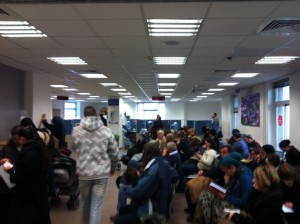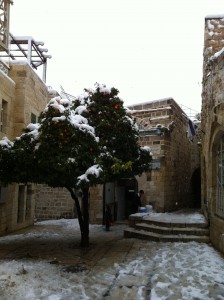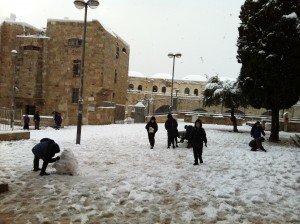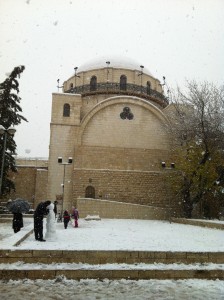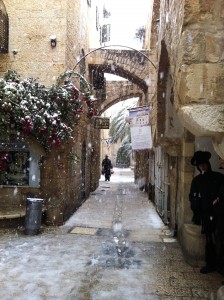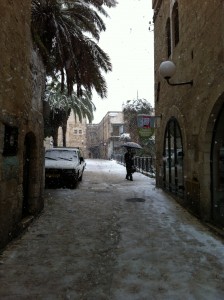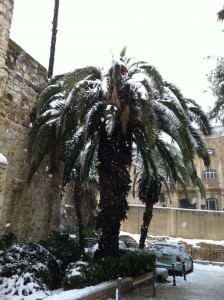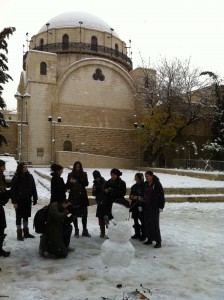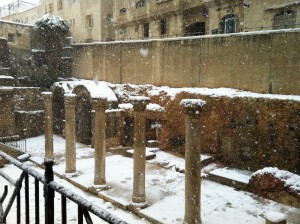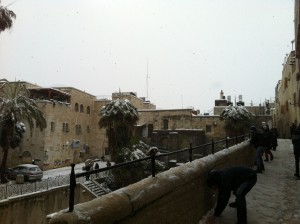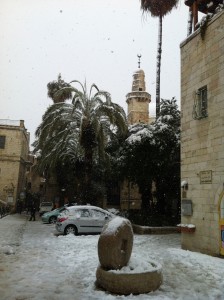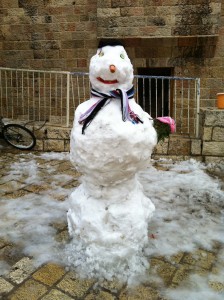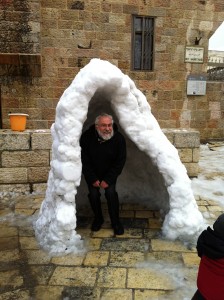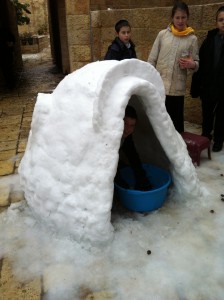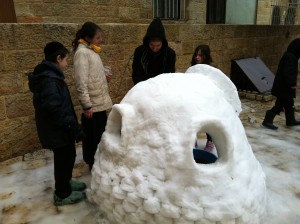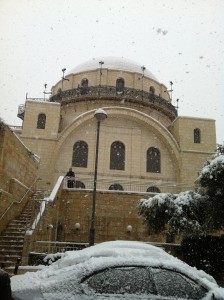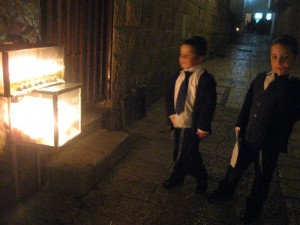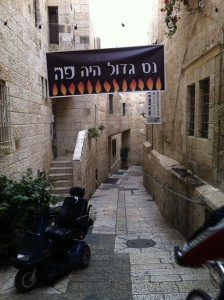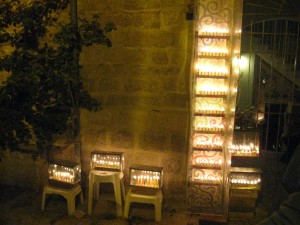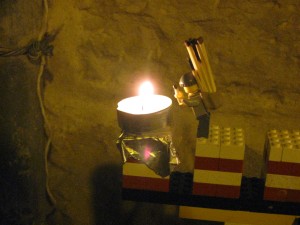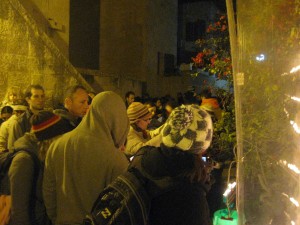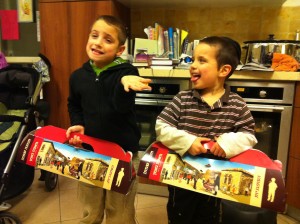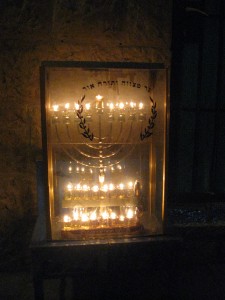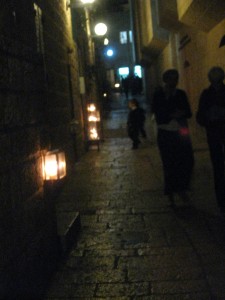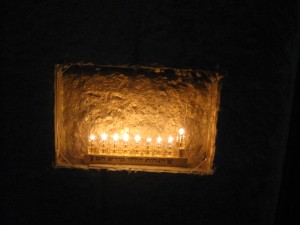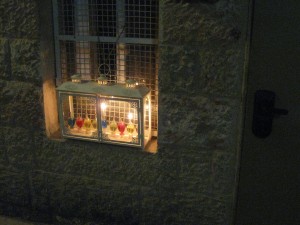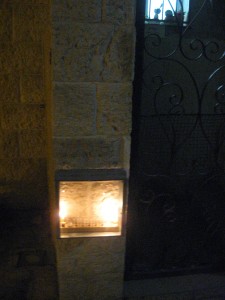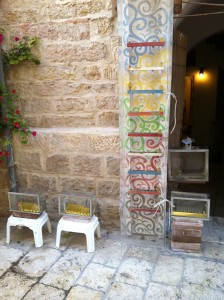Here it is, almost the end of Pesach, and I still haven’t put up a post about Purim. I also have pics and thoughts about Pesach preparations. But the first thing I would up writing was a post about some interesting Kosel & Har Habayis experiences, so I think I’ll put that up shortly rather than wait until I get the other stuff done. I thought being bein hazemanim would mean plenty of time for blogging, but other things (Pesach prep!) have gotten in the way. Also, blogging is a lot harder than I thought it would be, so it gets pushed down the list.
Category Archives: Being there
Coda
Today was a different kind of Rova day. When I discovered something had gone wrong with our transition to the government system (Betuach Leumi) paying for our health care I was not feeling a surge of enthusiasm for this country. The woman who had romantic notions of nobly making the ultimate sacrifice yesterday was now completely stressed and put out to have to sacrifice time, effort and pride to unravel the mess. Somehow dealing with forms and miscommunication doesn’t feel so romantic and noble.
So today I salute (and am in awe of) all the olim (immigrants to Israel) I know. These brave souls spend years being the greenhorns battling gaps in language, culture, and influence. They are not running from pogroms and the army like my ancestors did when they came to America. Instead they leave behind comfortable lives where they generally know what is going on to jump into a world where feeling foolish and incompetent is normal.
A Rova morning
Today was sort of the classic Rova morning, so I felt I had to share…
So, in the morning, while the older boys were in school, Mo and I were in our favorite makolet. I was not only shopping there, but was meeting a friend who had rented a car for the week and who had agreed to take my sheitel (wig) with hers to be styled for Passover. Meanwhile, it’s even more than the usual balagan (chaos) in the makolet, as they’re working to flip it over to Passover products. The two aisles are full of boxes to be shelved which meant that Mo in his happy green stroller was often in the way.
I’m in line waiting to pay, behind a very large order, and a nervous looking man comes up who only needs a loaf of bread. He’s late to work, so we let him in. Then comes a little boy, maybe 5 years old, buying lachmania (the classic rolls that the kids here all eat) and that cheese/yogurt stuff that Israelis have for breakfast (they often drink it, I use a spoon). The cashier is a terse but kind Russian woman who never loses sight of this boy. While juggling other customers, she makes sure he has his change, and his food, and is okay.
In the middle of all of this, a bar mitzvah passes by the open doorway. They are a regular, and loud (horns and drums), part of Mondays and Thursdays in the Rova. This is a big one, with a mix of more modern-looking types together with some long peyos (side-locks), all wearing cute matching Che-like t-shirts featuring an outline of the bar mitzvah boy. Other than me, no one in the makolet pays the passing procession any mind.
When I go outside, the little boy with the lachmania and cheese is there, looking anxious. I ask him if he needs help. He doesn’t want to talk to me, but eventually shakes his head. He’s too busy watching everyone go by. I am not the only one fascinated by the street scenes of the Rova.
I walk along towards the ATM, appreciating what a classic Rova day this is, and feeling happy to be here. Walking through Churva Square, with all of the disparate groups of Jews, I start thinking about the political situation and where I would fit if I lived here. A group of soldiers pass by, and I think about whether I would be willing to risk my life for this country. I’m startled that, in that moment, I think I would. A tear comes to my eye as I rumble along the stony square, feeling connected to everyone around me in a new way.
At the ATM on this sunny spring day (it was 80 degrees today!) I am still captivated by this feeling. It has been a dark dreary winter of colds and flus and little inspiration. I am so grateful and excited to feel inspired again. Then I realize: Wait, I’m right here! I can go down to the Kotel right now and channel this feeling into a spiritual experience. I look at my watch – yes! – it isn’t chatzos yet, so I can still daven (pray) shacharis (the morning service). Oh no, but I don’t have a siddur (prayer book). I’ll find one at the Wall – problem solved! I aim Mordechai’s happy green stroller down the road, dodge the bar mitzvah, tourists, and other mommies and look for the shortcut stairs that Dan says all the locals use. I bump the stoller down one flight and suddenly I remember: I bought yogurt. And it is among the first of the warm days. I can’t let Dan’s yogurt spoil just so I can live out some romantic notion. My prayers will also be heard from my house two minutes away, and I will have done something nice for my husband.
Back up the steps, through the crowd and homeward bound. Of course, I could theoretically still daven shacharis, but now I’m home. The baby is not interested in letting me salvage what’s left of my high, and there’s lots to do.
Another brush with the bureaucracy
Now that we’ve been here for six months, the health care system considers us quasi-insiders, and it was time for us to upgrade our Bituach Leumi status to non-paying members (thanks again, Israeli taxpayers!). This required a truly staggering array of forms and documents. We even had to get a copy of our marriage license, which turned out to be more expensive than difficult. (In an only-in-Israel touch, they would also have accepted a copy of our kesubah. I briefly considered asking our renter to take a digital pic of ours, which is hanging on the wall of our dining room in Chicago, but decided I didn’t want our health insurance riding on his unproven photographic skills.)
Among the documents we needed was confirmation from the Misrad Hapanim (Ministry of the Interior) of our comings & goings from Israel in the past 6 months – to show we’d really been here the whole time, earning our new status. Of course, this had to be done in person, by both of us. One government bureau may not consult the other directly, for some reason. We packed up Mordechai on a rainy morning, and headed over to the closest office, a short walk from the Old City.
No dramatic stories here, but it was amusing. There was the mix of Jews – charedim, chilonim, black, white, brown, Anglo, Russian, sabras, etc. – that is utterly typical here, but still can be dizzying for us chutzniks. One of the larger windows turned out actually to be a sliding-glass door opening to a tiny balcony on this 3rd-floor waiting room. So a guy wandered over, fiddled with it until it opened, and hopped out on the balcony for a smoke. This would never happen in America, because (1) the building would be totally, hermetically sealed; (2) even if it were physically possible, opening a window/door in a government office 3 stories up would trigger alarms; (3) smoking anywhere near the building, including on an outside balcony, would draw immediate sniper fire; (4) anything not expressly permitted by omnipresent signs in a government office is not only forbidden, but is potentially a felony; and (5) it would never occur to anyone sane that you could do such a thing. I pointed the guy out to Debbie and she just shrugged. The wife’s gone native!
When it was our turn, the very pregnant clerk was super-nice. Before we got down to business, there was first the fuss that needed to be made over Mordechai. (“Chamudi! Ben camma hu?” – “Sweetie! How old is he?” – with the appropriate baby faces.) She printed off our forms, we wished her b’sha’ah tovah, and we were on our way. Still, I couldn’t resist taking the snarky shot at the right, which was from a different department.
Snow day Part II
On the home front, it was a a chaotically mellow snow day. I (Debbie) was a bit surprised to wake up and find our back patio decorated in snow since I had been quite skeptical of all the hoopla running up to it. Quickly I shared the news with the kids and we were all a twitter with excitement as if we had never seen snow before.
Shalom’s school had already been canceled the day before. But what about Yitzi? There is no automated number to call for snow day info at his school. And I am certainly not high on the list to receive phone calls. So, since we live one minute from school I bundled him up, packed his snack, and sent him off into the white wilderness to find out.
Shalom was mad to get out into that snow, and put on his boots and jacket faster than I had ever seen before. He showed amazing patience for a four year old as he waited for me to finish breakfast, bundle up Mordechai, and bundle myself up.
Finally we made it out and all the neighbors were out playing in the snow, gawking, and smiling. It was this beautiful white slushy stuff great for packing together and building. Snow forts, snowmen, snowballs…
Yitzi came out to the square for recess and set to work as well. Turns out only half the class showed up that day, but they did have school. One mother came during school and brought popcorn for everybody, and the rebbe made steaming cups of tea to warm the boys up.
Shalom, Mordechai, and I were in and out all morning. Shalom got soaked and cold and would warm up and be back at it again. I just rolled with the day. Really, I had been wanting to get out of the Rova all week but stormy weather and sick kids had kept me in. Today I didn’t grumble about it. That’s the beauty of a snow day.
Snow in Jerusalem!
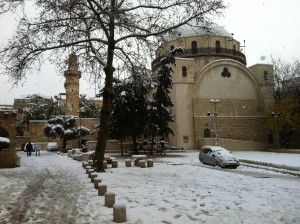 Everything here has ground to a halt as Jerusalem got the most snow it has seen in over 20 years. They said it was 20 cm in the city center (near us), and even more in outlying areas. I still haven’t quite mastered the metric system, but I’m pretty sure that 20 centimeters is about 4 feet.
Everything here has ground to a halt as Jerusalem got the most snow it has seen in over 20 years. They said it was 20 cm in the city center (near us), and even more in outlying areas. I still haven’t quite mastered the metric system, but I’m pretty sure that 20 centimeters is about 4 feet.
The boys are totally delighted, even though this would be routine back in Chicago (albeit not lately). They’re caught up in the excitement of the rest of the kids, who are absolutely beside themselves.
The local attitude is mostly to shrug, smile, and take the snow day. The schools are closed (except Yitzi’s school, Zilberman’s, which isn’t so surprising if you know anything about Zilberman’s), as are virtually all of the stores, restaurants, etc. Starting last night, they made the buses and train free in Jerusalem, to discourage people from driving. But then they suspended service on most of the buses, and the rest this morning when it really started to come down. The city does apparently have some snow removal equipment, but it’s clear that this will all be melted away shortly anyway.
At my yeshiva, those who live outside the Rova weren’t able to come in the morning, and there was a festive atmosphere for the rest of us. Instead of our usual Thursday schedule (review of the week’s daf, followed by a test), the whole yeshiva is learning a sugya on snow (at the bottom of Niddah 17A). Some guys brought in snowballs for inspiration.
Some more photos I took this morning are below. Enjoy.
Chanukah
It has already been nearly a month since Chanukah, but it was certainly an experience worth revisiting. (Not to mention that I’m finding blogging in a consistent and timely way to be much harder than it seems.) Growing up, I always dreamed of being in Israel for Chanukah.[1] I realized that dream last year, when we were here in Jerusalem for much of Chanukah. But living in the Rova this year took things to a whole new level.
In Israel, chanukiot are put outside the home when possible, in glass boxes made for that purpose.[2] In the Rova, some apartments have notches in the outside stone wall specifically made for chanukiot. Virtually every door has a chanukia outside of it, and many have several – the custom is for each child in the house to light one, in addition to the parents’, and multiple apartments in the same building may light at the same outside door, as was the case for us. The overall effect is stunning, with lines of boxes filled with light lining the cobbled streets of the Rova.
All of the holidays bring a surge in the already-numerous tourists here in the Rova, but Chanukah is unique. One major difference is that, for Chanukah, the overwhelming majority of visitors are (non-religious) Israelis. They come in every night to see the chanukiot, mostly in tour groups. As Chanukah goes on, the crowds keep getting bigger, and start coming earlier. Many come to see lighting itself, which happens here promptly at sunset.[3] Although we live on a normally-sleepy street, our building is a particularly popular Chanukah tourist destination. So, for example, when I stepped out to get ready to light on the seventh night, this is what was waiting for me:
Part of the reason our place is so popular is the large and lovely, hand-painted chanukia case of our neighbors, the Deutsches, and the Lego chanukiot of our other neighbors, the Shores. But they’re not the main reason. Debbie described it well in an email she wrote up for people back in Chicago:
As Chanukah comes to an end I just wanted to share a special part of our Chanukah here in the Old City. A number of years ago a neighbor of mine was part of an Ahavas Yisrael group[4] and trying to think of ideas to fulfill this mitzvah. Now, living in the Old City can feel like living in Disney Land with tourists constantly coming and going. Many folks have moved out of the Rova for this reason. But my beautiful neighbor chose to embrace this element of our neighborhood. During Chanukah most of the tourists are Israelis. She decided to set up a table in front of our building and hand out hot drinks.
It was a hit.
The kids in the building love it and have taken over setting up and manning the table. My kids think it is the best thing ever and Yitzi delighted in handing out candy we found in our cupboard.
The crowds build every night as people come to look at the chanukiot and have a warm treat. Tour groups come and my amazing neighbor brings them into her home and gives a little spiel on the holiday and offers for them to light (note: her husband works for Aish. Still it is amazing to give over one’s home night after night to large groups for this). The feeling is not kiruvy,[5] it is warm, happy, ahava. Everyone is smiling and when I peek out into the crowds, they thank me.
One man knocked on the door looking for medicine for his daughter who was not feeling well. I gave him what I had, and later the mother and daughter came to say thank you. It was so Israeli and lovely as we just felt connected.
It is amazing to me how much the intention of one’s acts can affect everyone. My street is mobbed for a week, which makes running errands and such more difficult. But the feeling is so happy and good, I don’t really mind. I am so inspired by being with happy Jews who are happy being together. Jews who don’t normally get to interact with each other.
I second everything Debbie said, with one caveat. It feels wonderful to “host” secular Israelis and celebrate this holiday together with them. The one wistful thing is the feeling that many are tourists not only to the Rova, but also to Chanukah. They take pictures of their kids next to other families’ chanukiot. They film others lighting the chanukia, saying the brachos, and singing Haneiros Halleilu and Maos Tzur.[6] They happily, but often sheepishly, wish us Chanukah sameach. I’m sure many do make Chanukah at home, but I’m also sure that many (more?) do not. I hope the light they brought back home from the Rova finds “kindling” there, as well.
When it comes to holiday foods, America and Israel seem to have opposite approaches regarding latkes and sufganiot. The emphasis in the U.S. is on the latkes, which are everywhere, while sufganiyot are available but not so prevalent. The converse is true here – latkes are not so easy to find, while sufganiyot are dominant. The bakeries in the Rova could barely keep up with the demand. During the tourist crush of the holiday, they were constantly cranking out trays and trays of a whole variety of sufganiyot (i.e., different fillings & toppings). There were even special boxes to carry them home.
In Chicago, “sufganiyot” really just means eating donuts at Chanukah time. They’re no different from the ones we eat all year. But, in Israel, donuts are pretty much only a Chanukah treat. Sure, you’ll see the occasional lonely box of Entenmann’s-style donuts at the makolet – usually adorned with the description “American-style” and a U.S. flag – but that’s about it. Israeli sufganiyot are much doughier than American donuts, and are almost exclusively the filled kind. I had a good time with the sufganiyot, but could’ve used some more latkes. Having no food processor (we’re trying not to buy so many appliances, which we’d wind up leaving here anyway) made it not so feasible to crank out our own, and no one seemed to be selling them.
I’ll wrap up this post with a gallery of some pictures of chanukiot around the Rova. But first is a 2-minute video someone made of Chanukah in Jerusalem. The initial :30 or so is shot in the Rova. I actually recognize several of these chanukiot (although ours did not make the cut, apparently). The next :30 or so was shot at Mamilla mall, which is just outside the Old City:
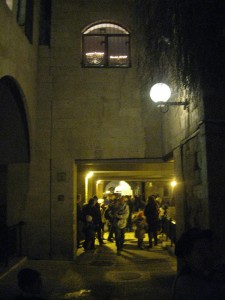
A friend of Shalom’s from school lives with his family in an apartment that overlooks a popular Rova thoroughfare – their chanukiot were in the video.
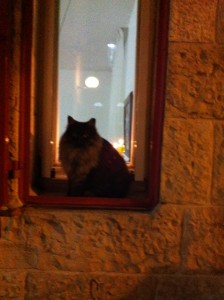
Like cats everywhere, the Jerusalem variety know when people are looking at a particular spot, and insert themselves accordingly.

The traditional candy bar / bamba / jelly bean chanukiot.
A Boy’s Life
After almost five months here, we finally have a sense of normal and dare I say routine. Well as much routine as a family of young children in a foreign country can manage. Here is a basic outline of the boys’ day:
7:00am: wake up time (except we rarely manage to be awake at this time)
7:15am: oh, no! get out of bed! get out of bed!
7:20am: Yitzi, get dressed! Shalom, Yitzi can’t play now it’s time for school!
7:30am: Yitzi comes downstairs dressed (mostly) and has breakfast. We still have American style breakfasts of oatmeal/cereal. From what I understand Israelis eat exotic dairy products and salad and such. Shalom is hopefully also dressed and eating. I am happy if at least one of those activities is occurring. Mordechai has yet to have a real routine. Sometimes he is awake at this point, sometimes he sleeps through the excitement.
7:45am: Yitzi heads to school. The official start time is 7:30 but after a month or so I discovered almost nobody is there at that time including the teacher (rebbe). I aim to send him in the middle, not the first boy and not the last. We live about one minute away from his school. Israeli kids are known for being more independent and so Yitzi would be mortified if I walked him to school.
8:00am: Shalom’s school begins. Again I have discovered most boys don’t come on time. For my own sanity I try to get him out of the house by 8:15. His class is a minute and a half from us. Just recently I started letting him walk by himself to school though 4 year olds are a little more prone to wandering about on their way. We’ll see…
SCHOOL: Dan or I will probably post more later about their school. It is a chareidi (ultra orthodox for want of a better word) school run by the Zilberman family. The boys’ rebbes do not really speak any English so all instruction is in Hebrew. Many of the boys in their classes come from English speaking homes which has been good and bad for the boys. It has eased their adjustment but slowed down their language skills.
Shalom goes to school Sunday-Thursday from 8:00 to 1:00 and on Fridays until 12:00pm. Yitzi has school Sunday-Friday from 7:30-1:00 and on Saturdays (Shabbat) from 2:00-3:30pm. Yitzi is actually really happy to be going to school on Shabbat. It is not too long, includes a recess and treats, and is generally fun for him.
1:00pm (on a typical day) The boys come home from school with all their triumphs and grievances and we eat lunch. If we were Israeli we would be having a large meal probably involving schnitzel. We are Americans though and are currently in a melted cheese sandwich rut. Dan comes home from yeshivah for a lunch break around 2:00pm.
2:30 Yitzi’s Hebrew tutor comes. During this time I am often working with Shalom on his reading homework from school. Yitzi also spends some afternoons working in a math book that we brought so he could keep up with his class in Chicago.
Chugim – So with school getting out so early here, what is a mommy to do? Enter the chugim industry. A plethora of after school clubs/activities (chugim) pop up every fall to entertain, educate, and enrich. I limited the boys to two chugim that they both attend. On Sundays we go to Mommy and Me Music with Ima Debbie (not me, phew!). A very talented mother leads the kids through songs and stories mostly in English. It has been a great release for the boys with comfortable and familiar songs in a welcoming fun environment. On Tuesdays they go to a cooking class run by a sweet teenage girl out of her home. This chug is mainly in Hebrew but the boys love it. I am not totally sure why. They make cookies, challah, blintzes, even a salad. I think the girl just has a good way of making all the boys feel special and helpful. Or maybe it’s just for the cookies.
6:00pm We are heading to dinner if I am lucky.
Wishful thinking bedtimes – Shalom by 7:00 and Yitzi by 8:00. I don’t know if it’s the new baby or being in Israel but my firm grip on bedtimes has disintegrated.
Between Channukah and catching many (though blissfully not all) Israeli viruses we haven’t been getting out of the Old City too much lately. Before then we would go out once or twice a week to do errands or explore. The boys love going on the bus or train. They are not so fond of all the walking our car-less urban life includes. Before winter really set in we would also spend more time playing outside particularly in the square by our house. I assume once the days get longer again we will be drawn back outside again.
Sirens in Jerusalem
Well, I guess now it’s personal.
No, no – we’re fine, everything here is fine.
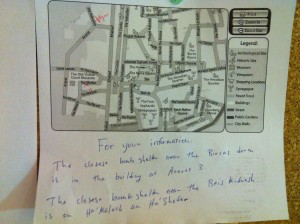
Ironic that I didn’t hear the sirens at the yeshiva, because at least there we know where the miklat is.
Last evening, just after Shabbos started, the sirens went off. I was at the yeshiva for services, where we didn’t hear anything. But here at home, they were ear-splitting (friends who were at the Kotel said they couldn’t hear any sirens, but authorities got on the loudspeaker and ordered everyone into shelter). We had no idea where the miklat (shelter) closest to our apartment is, so Debbie grabbed up the kids and ran outside, counting on following the neighbors there. The good news: the neighbors led her right to the miklat, and it is very close, just across the street. The bad news: it wasn’t open. The group went looking for alternatives, but then the siren ended, so Debbie spent some time hanging out with neighbors and discussing alternatives, then came home. I got home to the story, and we went on with Shabbos as usual.
There were lots of rumors over Shabbos about how many rockets there were, and where they landed. We now know that there was one, and it didn’t make it to Jerusalem. It apparently landed in an empty area somewhere in the Gush Etzion area (south of Jerusalem, and well south of us).
So, we had a little excitement, but they missed us. By a lot. And we’re safe, there’s no need for anyone to worry. Just in case, the miklat is now open, and the neighbors are discussing preparations like stocking it with basic supplies. I had been hoping for twinkies…
Healthcare in Israel
After three months here, we’ve now had some exposure to the Israeli healthcare system – a bit more than we’d have liked, to be honest – and I thought I’d share our experience.
DISCLAIMER: I’m not trying to make any sweeping statements here about the Israeli or American healthcare systems. This is simply our own anecdotal experience, nothing more. In fact, not only do we have a very small sample size, but some of it may be particular to being in the Rova.
The exact structure and nature of the various healthcare entities here remains something of a mystery to us, so my summary may not be quite accurate. But this very uncertainty is also part of the authentic experience, so I’m not going to do a lot of “outside” research to clarify it for this post.
Everyone here pays the government for heath insurance, either via an income tax that ranges from 3-5%, or on a fee-per-person basis (if, like us, you are not employed here). This insurance entitles you to join one of the four HMOs that provide healthcare services, which HMOs apparently are paid by the government based on enrollment and other factors. Whether they are private companies, or quasi-public, or whatever, I don’t know. They vary somewhat, and you need to determine which services each provides (and doesn’t provide) and other factors (e.g., which is closest to you, or is best in your area) to decide which one to join, although you can switch between them. Meuchedet was strongly recommended to us. Also, it is one of just two that are here in the Rova. You can get supplementary insurance, which entitles you to additional services, though we won’t be eligible to buy it until we’ve been here 6 months. I understand that you can also get private healthcare, outside the ambit of the national plan and HMOs, but I don’t know much about its availability or cost.
In addition, for babies, there is the (government agency?) Tipat Chalav. It handles immunizations and basic baby development (height, weight, etc.).
Thank G-d, we haven’t had any serious problems, but we have had occasion to experience walk-in clinic assistance, treatment by specialists, attempted treatment by specialists, and a Tipat Chalav check-up. Here’s the good and not-so-good of it.
The Good
Most of the providers have been very helpful, concerned, and friendly. Over Rosh Hashanah, a nasty stomach bug made its way through the family. We each got it to varying degrees (except the baby, Baruch Hashem), but Debbie really got hit hard. Exacerbated by the fact that she was nursing, Debbie got dehydrated and needed to get some IV fluids the day after Yom Tov. She was able to make the short walk to the Meuchedet clinic (everywhere in the Rova is only a short walk), and they were lovely. There was no emergency-room-style wait – Debbie was promptly ushered in to the nurse’s office, made as comfortable as possible, and received immediate treatment. The nurse and doctor were both from South America, and kept switching between Hebrew, English, and Spanish amongst themselves. At one point, the doctor started singing “Don’t Cry for Me, Argentina” (apropos of nothing, but charming nevertheless), and I had to tell Debbie later that he sung in Spanish. She was so out of it that she couldn’t keep track of the languages, recognizing only that she understood him. After Debbie was settled in and getting her fluids, I came back home to relieve the emergency babysitter, and the nurse would call to ask me to bring food and come get Debbie when she was ready. It was much more personal and personable than I’m sure we would’ve experienced at home.
Similarly, the dermatologist to whom Yitzi was referred for a plantar wart was a super-nice South African fellow with a terrific manner.
The other good thing is that this is all very cheap. We paid a guy here 1,000 NIS (a little over $250) to get us signed up for Meuchedet (i.e., to handle the red tape and get us signed up immediately), which included the first 6 months of coverage for the family. There are some copays, but they’re hardly worth mentioning. Seeing a specialist costs something like 20 NIS (roughly $5), and that covers all of your visits to that specialist for the fiscal quarter. For the family, specialist copays are capped at about 200 NIS (~$50) per quarter. Prescription drug copays are generally 14 NIS (~$3.50) (they can cost more if the drugs are especially expensive).
Of course, it is super-cheap for us because we don’t pay any income taxes here – healthcare or otherwise – and we’re even exempt from the V.A.T. Also, I have no idea whether the national healthcare income tax covers all of the costs or if it has to be supplemented with other tax revenues. The bottom line is that we’d certainly like to thank the Israeli taxpayers for subsidizing us!
The Not-So-Good
In order to see a specialist, you have to get a referral – and almost everything requires a specialist. When Yitzi got a painful plantar wart on his heel, Debbie made an appointment and took him to the local Meuchedet office. The doctor took a quick look, then apologetically said we needed to take him to a dermatologist, and filled out a referral. It was then up to us to find one. The closest one was outside of the Rova, roughly a 15-minute bus ride away. This has turned out to be, by far, the easiest specialist referral we’ve had to arrange.
I have chronic problems with my ears, for which I see a hotshot specialist in Chicago. My ears need to be examined and cleaned every few months, at a minimum. In late September, when they started acting up, I called back to Chicago to get a referral. My doctor suggested his friend, the head of the ENT Dept. at Shaare Zedek hospital here in Jerusalem. I tried calling the doc’s office, which turned out to be its own challenge. His secretary was generally not there and – astonishingly – there was no voicemail. Eventually, I got ahold of her. She said I’d need to get a referral from Meuchedet, but she’d go ahead and schedule the appointment, but the first available was December 11. When I went to Meuchedet to get the referral, the doctor there told me that she could not refer me to a Shaare Tzedek doctor. I had to first see a Meuchedet ENT, who could then refer me if it was warranted. The soonest available Meuchedet ENT appointment was in three weeks, in Har Nof (a Jerusalem neighborhood about an hour away via public transportation). When I went to see her, she did not give me a referral, but treated me. I’ve decided not to make a stink just yet, unless we don’t see any improvement.
A couple of weeks ago, Baby Mordechai developed a nasty eye infection and possible blocked tear duct. Needless to say, he was going to need to see an eye specialist. Debbie got some recommendations and tried to make an appointment. She was told she couldn’t get an appointment yet, but should call back… in December.
Another thing about the healthcare infrastructure (which also seems to generally be true with many of the institutions here, like the phone companies, UPS, Egged, etc.) is that you’ll experience significantly different policies and procedures, depending on who you happen to talk to. For example, when Yitzi went in for his wart, he was told he had to go to a dermatologist. When I went in for my ear (to get a referral), I also pointed out that I, too, had a plantar wart that was bothering me. The doctor barely glanced at my foot, and prescribed a topical, with no further instructions or advice.
In fact, that doctor was the exception to the general rule of kind and friendly care (she was not the Evita-singing caretaker of Debbie’s visit). When I went in to see her, and asked if she spoke English, she gave me a brusque (and mildly hostile) “no.” But when I tried to describe my ear condition in my broken Hebrew, a miracle occurred, and she was suddenly able to speak very serviceable English. Even then, she was not too interested in the reasons I came to see her, wanting instead to talk about my diet and exercise regimen. To be sure, I certainly need to lose weight – in fact, I’ve been eating better and have been more active here, and have been losing weight – but I would have appreciated at least token attention to the things that brought me to her in the first place.
The In-Between
Debbie’s Tipat Chalav visit with Mordechai didn’t live up to stories we’d heard of being overly hectoring. She reports that the nurse was very nice. But it is worth noting that Tipat Chalav provides a card on which they hand-write the baby’s growth data (measurements, weight, etc.), together with a handwritten vaccination record. Although all of this data is inputted into Tipat Chalav’s computer system, parents must keep these and bring them to each appointment, or else no baby well-care will be provided. The nurse explained to Debbie that this Israeli system is superior to the apparently confusing printout of Mordechai’s information from our doctor at home.

